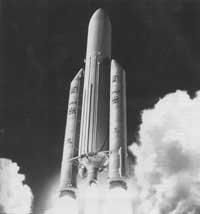Millions dragged by fire
The new ESA pitcher (European Space Agency) is designed to replace Ariane IV. Ariane V, more modern and powerful, has great expectations about the possibilities that the new pitcher opens. However, fate has been overwhelmed by the intentions of Europeans and the bad combustion of a rocket has made ESA engineers forced to break the launcher to avoid more serious damage.
Ariane IV needs 10 engines to put in space a weight of 2.5 tons. Meanwhile, Ariane V has only four engines and is able to space 5 tons. Having fewer and more powerful engines should ensure that it is cheaper, reliable and operable than its predecessor. Unfortunately it has not been so in the first session.
Ariane V a is meant to be the last glorious step of a strategy designed in 1973. This strategy focuses on the launch of commercially used geostable orbit satellites. The launch of the first Ariane (December 24, 1979) and seventeen years later the good European strategy has been confirmed. Between 1972 and 1979, 37 geostable telecommunications satellites were launched, which fired a $2 billion market. Between 1980 and 1989, 99 satellites were issued, amounting to 6.39 billion dollars. Between 1990 and 1999, 135 satellites will be launched and the resulting market will be 12.15 billion dollars.
The Ariane launchers have a high reliability (success of 91.6%) and allow to launch two satellites simultaneously. In fact, 44 of the 84 releases have been double or triple. Therefore, it has a market share of 59%. The rest is divided into: 15% in the USA, 10% Long Chinese Tour, 9% Russian Protn and 6% Delta USA . ESA wants to maintain and, as far as possible, expand this market share.
Not everything is gold

Around this source of millions not everything is red gold. Some include serious ecological problems. First, we should mention the transformation that Kourou has undergone in French Guiana, since in 1964 it was a hundred inhabitants and now has 20,000 inhabitants, employees of ESA, in large part. However, the damage is done: what was an ancient tropical is today a cement zone.
The concern of ecologists and several biologists is the detrimental effect that the combustion gases generated in the shots can have, especially in the fauna and vegetation of the area. The problem is dark, especially because of ESA's untransparent behavior. In 1987 the CNES (French Space Agency) conducted a six-volume study analyzing all aspects of the launch. Two of these volumes referred to the environmental impact. The studio has never seen light.
Ariane V has two solid fuel rockets with 237 tons of propellents each. In two-minute streams, the propellers burn whole and in the process 156 tons of aluminum oxide, 128 tons of carbon oxides, 96 tons of hydrogen chloride (hydrochloric acid), 36 tons of nitrogen, 14 tons of hydrogen and 24 tons of water vapor are generated. All of this falls into the surrounding jungle and ocean.
The main problem of contamination is hydrochloric acid that forms when hydrogen chlorides are dissolved in water. The water is sprayed into the exhaust pipe to absorb the vibrations of the propulsor being burned, otherwise these vibrations would damage the rocket. The water comes out of the exhaust in the form of acid rain cloud.
However, the problem is not exclusive to Ariane. For example, similar exhaust gases are formed in US ferry launches or Titan launchers. However, the launch base of Cape Cañaberal is built on shells and its calcium carbonate eliminates the influence of acids.
On the other hand, all space launchers can cause long-term pollution problems. In fact, it is not very clear what effects can have on the stratosphere those large amounts of gases that are injected into the atmosphere. According to a 1991 study, rocket shots in 1991 reduced the ozone layer by 0.1%. Small amount, regardless of its representativeness.
It does not seem that the accident of June 4 nor the ecological problems cut the future of Ariane V. ESA wishes you a promising future and so we wish you, although concern for ecological problems somewhat obscure our desire.
At nine and 35 minutes in the morning of June 4 began the great passage of Ariane V. The new Vulkano engine powered by 132 tons of hydrogen and 36 tons of liquid oxygen begins to operate. Seven seconds later the two solid fuel side rockets were lit. These rockets account for 90% of the initial boost. The pitcher began to rise leaving behind the trail of the suspension. At thirty-seven seconds, when the projector was 3,400 m, some devices of the rockets were blocked. The pitcher began to twist and at the same time stressed the structure. At that time the system of internal self-destruction was launched and almost simultaneously the order of destruction was issued from the ground control. A ball of fire was lit in the sky. |





